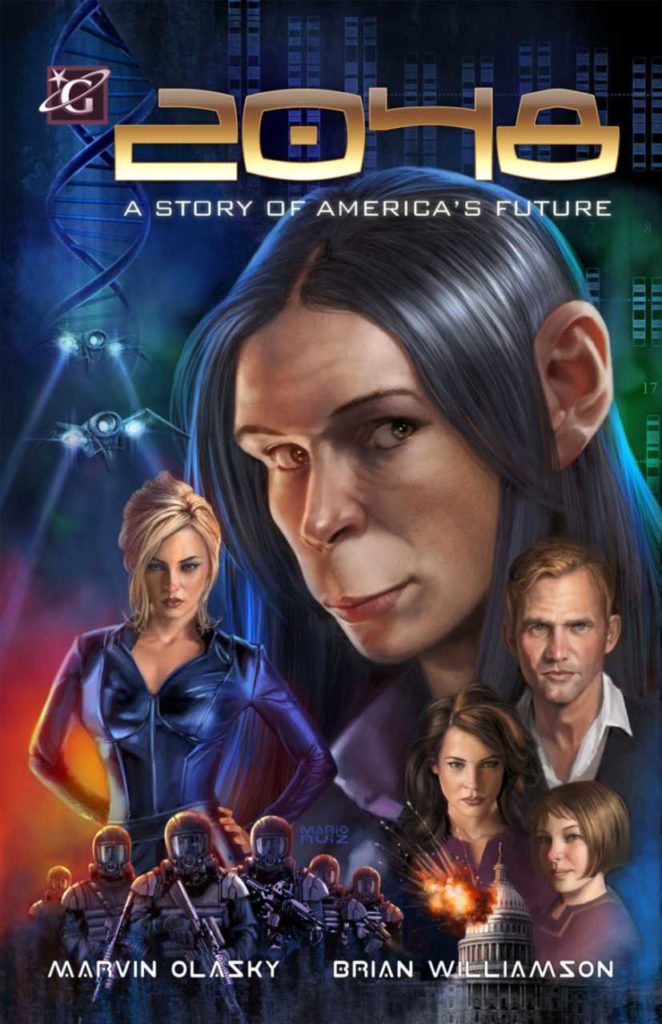‘2048’ Asks How Christians Could Respond To Human/Animal Hybrids
What happens when scientists succeed in creating human-animal hybrids? This is the question raised by Martin Olasky, editor-in-chief of World Magazine in his 2010 graphic novel, 2048: A Story of America’s Future with art by Brian Williamson.
In 2048, scientists have found a way to create hybrids that are a mix between humans and bonobos, called bumans. The hybrids are sterile and their IQ at the high end is in the high 80s but they also have incredible strength. A moratorium has been placed on the creation of new bumans, but the question looms large: what to do with those who are here?
This is particularly true for Christian baseball player turned U.S. Senator Josh Logan, who tries to determine what to do with the bumans already created. His life is complicated when he meets a buman named Bonnie. Bonnie was the victim of an attempted sexual assault at the start of the story. She has been pushed out from her home by the other bumans who wrongly blamed her for the assault and feared “her conduct” would cause humans to think that bumans are bad. Logan invites Bonnie to his home to meet his family and allows Bonnie to stay with them until she can find other arrangements.
The book deserves a lot of credit for examining this question from so many sides. There are people who are scared of losing their jobs and scared of the bumans’ physical strength. Logan’s son raises the fear that bumans will be allowed to compete in high school athletics, making it hard for humans to make the team. Because of this, there have been a group of violent vigilantes called Bruisers who act out of irrationality and fear of the bumans.
Logan is shown having two key groups of supporters who are opposed to each other on the issue. “Christian” moralists want all existing bumans locked in prison camps. But capitalist entrepreneur supporters dream of ending the moratorium on new bumans, and support the mass exploitation of bumans by corporations and the American people. One capitalist even warns that if Logan doesn’t go along with this plan, the capitalist will switch to Logan’s opponent who’d favor exploiting them as sex workers.
Meanwhile, Logan and his family are getting to know Bonnie. Logan is wondering whether Bonnie has a soul and if she does then how should she and other bumans be treated?
This book raises some deep questions and is unlike most Christian books that tend to deal with moral issues that are more black and white. What this book does is take a decent character and throw him into uncharted moral waters. It’s a very rich and powerful question that has him looking for the right thing and trying to find the courage to do it. It makes Logan an interesting and likable character that I found relatable and admirable.
The story is also manages some solid religious and political satire. One of the book’s big plot twists is pushed when a buman rights group pushes for Bonnie, who has a third-grade level of intelligence, to be allowed to attend third grade with human children despite her being full grown. It’s absurd and guaranteed to create a backlash, but what’s made clear is that this group cares more about rights in the abstract and less about actual people who end up being collateral damage.
By 2048, Megachurches have been replaced with Gigachurches with lightning shows during the worship service and a pastor cries out, “Are you ready for some baptisms?” like the coming baptismal service is a WWE match. All these are subtle and not-so-subtle digs at the way church can try too hard to entertain.
The art is well-done and, at its best, it shows the power of the graphic novel as a storytelling medium. The old saying about a picture being worth a thousand words really holds true here as the characters’ feelings and thoughts come through with facial expression and posture. So much of the senator’s relationship with his wife comes through in a way that just couldn’t be done in a regular novel.
While the core of the story is good, the novel isn’t without flaws. The big one is the villain. Logan’s opponent in the Senate election, Vivica Sprawl, wears cat suits everywhere and is identified as a “Pornographess Supreme,” who has a dungeon-themed living room. She looks and acts as if she was headed to a Batman comic book and stumbled into this one by mistake. Given the serious nature of the book, having a campy, over-the-top villain is just out of place. It also undermines the credibility of the threat to Logan’s political career.
The book doesn’t require an opponent. It’s about Logan’s struggle to discover the right action and do it no matter the consequences might be. One consequence is the threat of losing re-election, and he doesn’t need a specific person to be that threat, particularly when it’s hard to take this person seriously.
In addition, there are a couple subplots that come out of nowhere and didn’t go anywhere. I also question whether some scenes that were given full page spreads really merited that emphasis. It was a good book, but I think it could have been thirty pages shorter and been an even better one.
Still, the book deserves credit for what it does right. It presents a truly tough dilemma and doesn’t offer easy answers, while warning against the knee-jerk Phariseeism and pride so many find easy to fall back upon. While not perfect, it’s a definitely a worthwhile read.







































“Shin Sekai Yori” already did it. Except in there the idea of bonobo genes was to make humanity less aggressive as a species, because bonobos resolve conflict through sexual contact. Really.
And then that raises the question of why Bonnie would be expelled from buman society. I’d have to do more research, ’cause I don’t know if bonobos actually practice ostracism. Theoretically they could have enough human in them for shame and shunning to actually mean something to them, but that doesn’t mean some buman equivalent of mutual grooming couldn’t smooth feelings out within the society.
But the Plot Must Go On, I suppose.